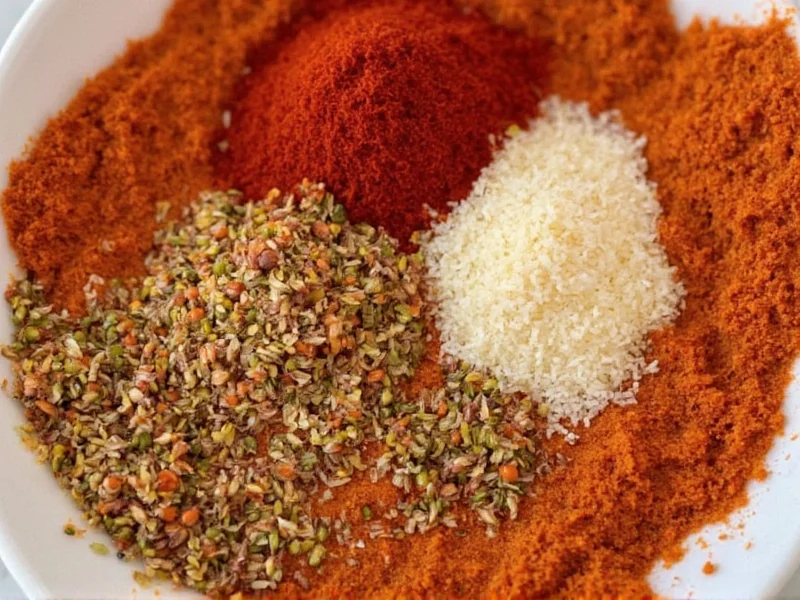Understanding Tajin Seasoning's Unique Flavor Profile
Tajin (pronounced "tah-heen") offers a balanced combination of three core elements: mild chile heat from guajillo and other peppers, bright citrus notes from dehydrated lime, and subtle saltiness. Unlike many spice blends, Tajin contains no artificial colors or flavors, making it a clean-label option for flavor enhancement. The seasoning's moderate Scoville rating (approximately 1,500-2,500 units) provides noticeable warmth without the intense burn found in hotter chili powders.
Core Ingredients and Nutritional Facts
The standard Tajin Clásico formula contains just three ingredients: salt, chile peppers, and dehydrated lime juice. This simplicity contributes to its versatility across culinary applications. A single 1/4 teaspoon serving (the typical usage amount) contains:
| Nutrient | Amount per 1/4 tsp | % Daily Value |
|---|---|---|
| Calories | 0 | 0% |
| Total Fat | 0g | 0% |
| Sodium | 135mg | 6% |
| Total Carbohydrate | 0g | 0% |
| Protein | 0g | 0% |
For those monitoring sodium intake, Tajin offers a reduced-sodium version that contains 35% less salt while maintaining the characteristic flavor profile. The seasoning is naturally gluten-free, vegan, and contains no preservatives.
Traditional and Creative Uses for Tajin Seasoning
While many first encounter Tajin on fresh fruit in Mexico and Central America, its applications extend far beyond this classic preparation. Understanding how to use Tajin seasoning properly can transform ordinary dishes into restaurant-quality creations.
Fruit Enhancements
The most traditional application involves sprinkling Tajin on fresh fruit, particularly:
- Mango slices (often served with a squeeze of lime)
- Pineapple chunks
- Watermelon wedges
- Green apple slices
- Cucumber sticks
This combination creates a sweet-spicy-tangy experience that balances the natural sugars in fruit. For best results when using Tajin seasoning on fruit, apply it just before serving to prevent the salt from drawing out excessive moisture.
Savory Applications
Chefs and home cooks increasingly incorporate Tajin into savory dishes:
- As a dry rub for grilled chicken, fish, or shrimp
- Mixed into salad dressings and vinaigrettes
- Added to roasted vegetables (especially corn, sweet potatoes, and zucchini)
- Seasoning for popcorn or roasted nuts
- Enhancing guacamole and other dips
Beverage Integration
Tajin has gained popularity as a rim seasoning for cocktails and non-alcoholic beverages:
- Margaretas (traditional salt rim alternative)
- Micheladas (Mexican beer cocktail)
- Fruit smoothies
- Limeade and other citrus beverages
Tajin vs. Similar Chili-Lime Seasonings
While several brands offer chili-lime blends, Tajin maintains distinctive characteristics that set it apart from alternatives. Understanding these differences helps when selecting the right seasoning for specific applications.
Tajin Clásico contains only salt, chile peppers, and lime, while many competitors add additional ingredients like citric acid, sugar, or anti-caking agents. This purity contributes to Tajin's cleaner flavor profile. When comparing Tajin vs. chili lime seasoning options, note that Tajin delivers more pronounced lime notes with moderate heat, whereas some alternatives emphasize either more heat or more citrus.
Proper Storage for Maximum Freshness
To maintain Tajin seasoning's vibrant flavor and color, store it properly:
- Keep in a cool, dark place away from heat sources
- Ensure the container is tightly sealed after each use
- Avoid storing above the stove or near dishwasher vents
- Use within 18-24 months of opening for optimal flavor
Exposure to moisture can cause clumping, but this doesn't affect safety—simply break up clumps with a clean, dry utensil. Properly stored Tajin maintains its characteristic bright red color and potent aroma.
Effective Tajin Substitutes
When you need a Tajin seasoning substitute, consider these alternatives based on your specific application:
- For fruit applications: Mix 2 parts chili powder, 1 part lime zest, and 1 part fine salt
- For savory dishes: Combine smoked paprika, cayenne, and lime juice concentrate
- Quick alternative: Use equal parts chili powder and lime salt (available in some markets)
While these substitutes approximate Tajin's flavor, they won't replicate it exactly due to Tajin's specific chile blend and manufacturing process. For authentic results in traditional Mexican preparations, seeking out genuine Tajin remains preferable.
Creative Recipe Ideas Beyond the Basics
Expand your culinary repertoire with these innovative Tajin applications:
Tajin-Spiced Watermelon Salad
Cube watermelon and feta cheese, toss with fresh mint, a light lime vinaigrette, and a generous sprinkle of Tajin. The seasoning enhances the watermelon's natural sweetness while complementing the salty feta.
Chili-Lime Roasted Chickpeas
Toss cooked chickpeas with olive oil, Tajin, and a touch of honey. Roast at 400°F until crispy for a protein-packed snack that satisfies both sweet and savory cravings.
Tajin-Infused Guacamole
Add 1/2 teaspoon Tajin to your standard guacamole recipe along with the lime juice. The additional chile notes deepen the flavor without overpowering the avocado's richness.
Addressing Common Tajin Questions
Many home cooks wonder about proper Tajin usage techniques and storage. The seasoning's versatility means it works across numerous applications, but understanding its limitations prevents disappointing results. When incorporating Tajin into beverages, add it gradually as its flavor intensifies when liquid is introduced. For baking applications, use Tajin in recipes with complementary flavors like chocolate or citrus, but avoid high-heat baking that might diminish its fresh lime notes.











 浙公网安备
33010002000092号
浙公网安备
33010002000092号 浙B2-20120091-4
浙B2-20120091-4